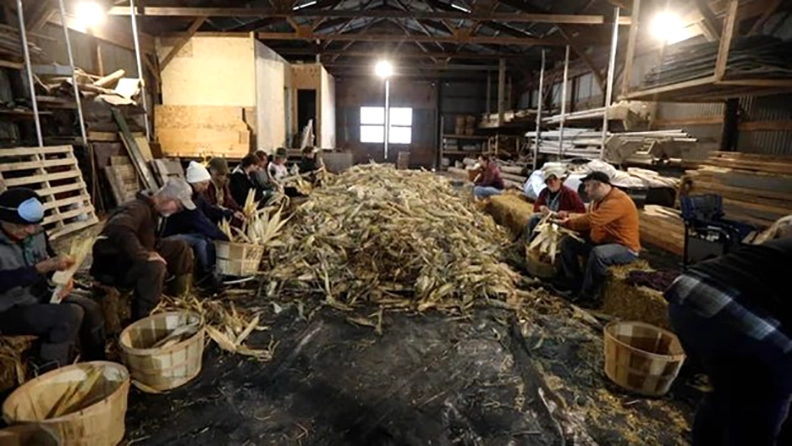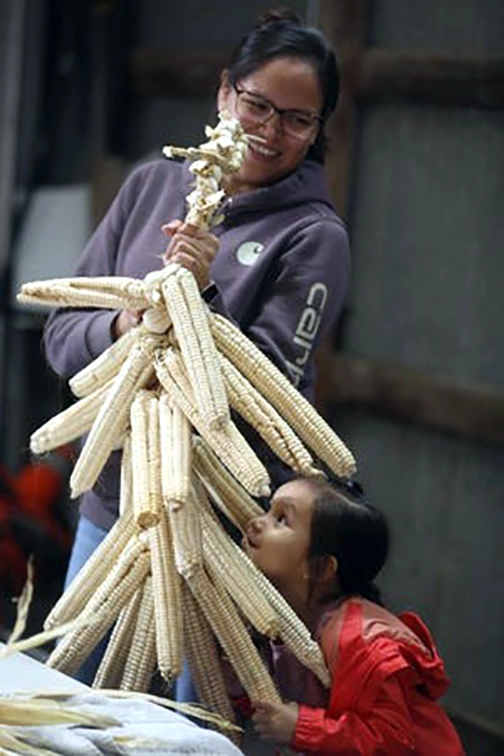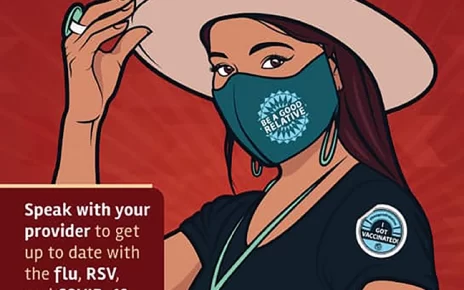January 2, 2024 | By Tina MacIntyre-Yee | Farmers’ Advance | farmersadvance.com
Photo above: Gerry Fisher, acting Director at Seneca Nation’s Gakwi:yo:h Farms, tosses some corn to the other end of the pile.
The only sound was the rustling of husks, carefully pulled down to save the three strongest for braiding the corn together.
This wasn’t just any corn. It was Haudenosaunee White Corn, the seeds passed down from generation to generation and its handling adhered to age-old traditions from planting to processing.
The batch was received three days prior and needed to be husked and braided, then hung to dry to prevent mold. After several months, the corn will be hand-sorted, cleaned, and bagged as hulled corn, roasted corn flour and corn flour.
“Corn is so essential to who we are. It’s what fed us,” said Peter Jemison, former site director of Ganondagan State Historic Site, who retired in February.
The struggle of the Haudenosaunee White Corn
The Haudenosaunee White Corn Project is in its 23rd year at the Ganondagan State Historic Site in Victor. The site has historical significance to the project.
In the 1600s, Ganondagan was the largest Seneca village and neighbored Fort Hill where the Haudenosaunee Confederacy stored grain. Any nation within that confederacy could access the food as needed.
However, in 1687 a French army came from Canada to attack the village as part of an effort to secure trade in the area. The Seneca knew of the attack in advance and left. The army chopped down crops and burned the stored corn at Fort Hill in hopes of starving the Seneca should they return.
This corn, a descendent of the ancient seeds, survived.
“The corn was definitely hiding to stay safe,” Angel Jimerson, consultant and former production manager at Ganondagan White Corn Project said.
The struggle to save the corn did not end there. When boarding schools later arrived, part of the mission was to quash the customs, language and tradition of the Haudenosaunee, Jimerson said. People had to hide their practices, languages, songs and foods.
Haudenosaunee believe corn isn’t just a crop. It’s a part of the Three Sisters, which also includes beans and squash. Besides being the agricultural staples, Haudenosaunee legend says people need to acknowledge the Three Sisters as relatives and include them in ceremonies.
Jimerson said their great grandfather was one of the few in the Cattaraugus Reservation who secretly kept growing corn in his small garden. He grew just enough so it could be processed, eaten and have some left to replant.
The continuation of the White Corn Project
Originally called the Iroquois White Corn Project, founders, John Mohawk and his wife, Yvonne Dion-Buffalo, wanted to introduce ancestral seeds and foods back into the Haudenosaunee diet on the Cattaraugus Reservation. Corn is the most labor intensive crop of the Three Sisters, so processing the corn and making it more available was important to the culture and health of the community.
When the couple died in the early 2000s, the project was dormant for years until Jemison, a cousin of John Mohawk, brought it to Ganondagan and restarted it.
“The idea is to get our own people to eat our own food,” Jemison said, and not just for special occasions.
Keeping tradition alive for future generations
Today, one of the challenges is to make sure the corn isn’t genetically modified or patented. Indigenous farmers are careful to plant at times that it won’t cross pollinate with other corn in the fields. All the seeds remain with the Indigenous community.
By midmorning, the barn at Ganondagan White Corn Project was a hum of activity. People chatted with those beside them. Some were first-timers, others had come before. Music, drumming and singing from an Indigenous social dance song, streamed from a phone and two young boys climbed up a corn pile, searching for corn silk to collect for use in medicine.
As people worked, they were asked to have what Haudenosaunee people call a “good mind,” which means to have respect and be mindful of your actions and thoughts.
Deb McPherson of Fairport attended for the first time with her cousin. Both are Potawatomi and came to support Ganondagan. McPherson noted that many of the Indigenous people have a connection to the same foods and have similar stories around it.
“It was almost like a replica of what was happening in the Long House, long ago,” McPherson said of the activity surrounding her.
“Just think how many people have touched that corn and when they’re getting braided, it’s everyone’s corn.”
It wasn’t just the corn she husked, she said. A basket she contributed to had corn husked by others the communal spirit is still there as they are braided together.
“They are hanging as a community as well.”









